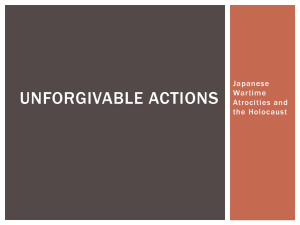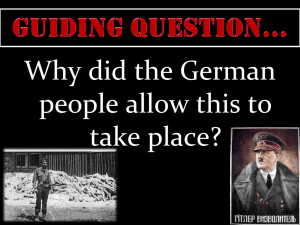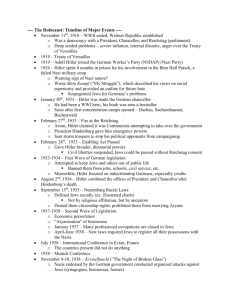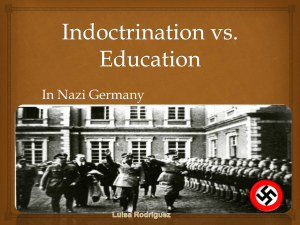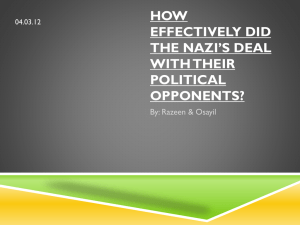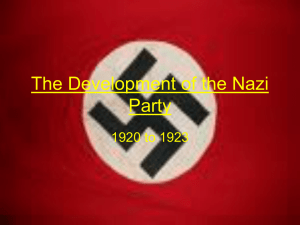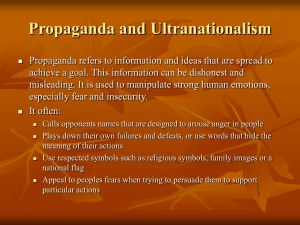Nazi Ideology and the Holocaust Guided Notes Text pages 766
advertisement
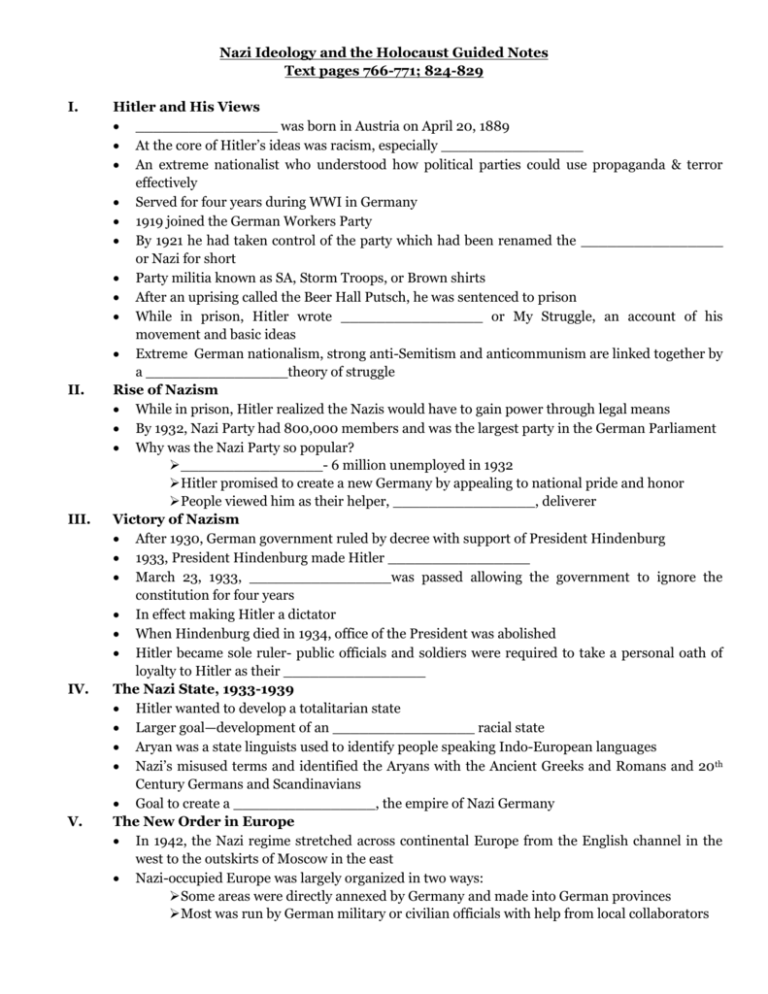
Nazi Ideology and the Holocaust Guided Notes Text pages 766-771; 824-829 I. II. III. IV. V. Hitler and His Views ________________ was born in Austria on April 20, 1889 At the core of Hitler’s ideas was racism, especially ________________ An extreme nationalist who understood how political parties could use propaganda & terror effectively Served for four years during WWI in Germany 1919 joined the German Workers Party By 1921 he had taken control of the party which had been renamed the ________________ or Nazi for short Party militia known as SA, Storm Troops, or Brown shirts After an uprising called the Beer Hall Putsch, he was sentenced to prison While in prison, Hitler wrote ________________ or My Struggle, an account of his movement and basic ideas Extreme German nationalism, strong anti-Semitism and anticommunism are linked together by a ________________theory of struggle Rise of Nazism While in prison, Hitler realized the Nazis would have to gain power through legal means By 1932, Nazi Party had 800,000 members and was the largest party in the German Parliament Why was the Nazi Party so popular? ________________- 6 million unemployed in 1932 Hitler promised to create a new Germany by appealing to national pride and honor People viewed him as their helper, ________________, deliverer Victory of Nazism After 1930, German government ruled by decree with support of President Hindenburg 1933, President Hindenburg made Hitler ________________ March 23, 1933, ________________was passed allowing the government to ignore the constitution for four years In effect making Hitler a dictator When Hindenburg died in 1934, office of the President was abolished Hitler became sole ruler- public officials and soldiers were required to take a personal oath of loyalty to Hitler as their ________________ The Nazi State, 1933-1939 Hitler wanted to develop a totalitarian state Larger goal—development of an ________________ racial state Aryan was a state linguists used to identify people speaking Indo-European languages Nazi’s misused terms and identified the Aryans with the Ancient Greeks and Romans and 20th Century Germans and Scandinavians Goal to create a ________________, the empire of Nazi Germany The New Order in Europe In 1942, the Nazi regime stretched across continental Europe from the English channel in the west to the outskirts of Moscow in the east Nazi-occupied Europe was largely organized in two ways: Some areas were directly annexed by Germany and made into German provinces Most was run by German military or civilian officials with help from local collaborators VI. Resettlement in the East Nazi administration in the conquered lands to the east was especially ruthless. They were populated, Nazis thought, by racially inferior Slavic peoples. Hitler’s plans for an Aryan racial empire were so important that he and the Nazis began to put their racial program into effect soon after the conquest of Poland. ________________, the leader of the SS, was put in charge of German resettlement plans in the east. Himmler’s plan was to move the Slavic peoples out and replace them with Germans. Slavic peoples included ________________. ________________Poles were uprooted and moved to southern Poland. By 1942, 2 million ethnic Germans had been brought in to settle Poland. Himmler told a gathering of SS officers that 30 million Slavs might die in order to achieve German plans in the east. VII. Slave Labor in Germany In 1942, a special office was set up to recruit labor for German farms & industries. By 1942, 7 million European workers were laboring in Germany. By summer of 1944, seven million European workers were forced to labor for the Nazis in their own countries. VIII. The Holocaust No aspect of the Nazi New Order was more terrifying than the deliberate attempt to exterminate the Jews. Racial struggle was a key element in Hitler’s world of ideas. On one side were the Aryans; on the other were the Jews, ________________ in Hitler’s view, who were trying to destroy the Aryans. Himmler and the SS closely shared Hitler’s racial ideas. The SS was given responsibility for what the Nazi’s called their ________________to the Jewish problem. The Final Solution was ________________—physical extermination—of the Jewish people. Reinhad Heydrich, head of the SS’s Security Service, was given the task of administering the Final Solution. After the defeat of Poland, he ordered forces to found up all Polish Jews and put them in ________________ set up in a number of Polish cities. Conditions in the ghettos were horrible—unsanitary housing & minimal amounts of food. June 1941, the forces were given the new job of acting as mobile killing units. ________________followed the regular army’s advance in the Soviet Union. Their job was to round up Jews, execute them, and bury them in mass graves. The graves were often giant pits dug by the victims themselves before they were shot. IX. The Death Camps Probably ________________Jews were killed by the death squads As appalling as that sounds, it was too slow by Nazi standards. They decided to build death camps to kill the European Jewish population more efficiently. Beginning in 1942, Jews from countries occupied by German were rounded up, packed like cattle into freight trains, and shipped to Poland. Six extermination centers were built for this purpose; the largest was ________________. About ________________of the arrivals to Auschwitz were sent to a labor camp, where they were starved or worked to death. The remainder were sent to the ________________. Some inmates were subjected to cruel and painful “medical” experiments. By the spring of 1942, the death camps were in full operation. X. XI. First priority was given to the elimination of the ghettos in Poland. By the summer of 1942, Jews were being stripped from France, Belgium, & Holland. Even as the Allies were winning the war in 1944, Jews were being shipped from Greece & Hungary. Despite desperate military needs, even late in the war when Germany faced utter defeat, the Final Solution had priority in using railroad cars. The Death Toll Germans killed between ________________, over three million in death camps. Virtually ________________ of the Jewish population of Poland, the Baltic countries, and Germany were killed. The Nazi’s were also responsible for the deliberate death by shooting, starvation, or overwork of at least 9 to 10 million other people. The Nazi’s considered the ________________ (gypsies) to be an alien race. They were rounded up for mass killing. About 40% of Europe’s one million Romas were killed in the death camps. The leading citizens of the Slavic peoples—clergy, intellectuals, civil leaders, judges, and lawyers were killed. Probably an additional ________________Poles, Ukrainians, and Belorussians lost their lives as slave laborers for Nazi Germany. Finally, probably at least 3-4 million Soviet POW’s were killed in captivity. This mass slaughter of European civilians is known as the ________________ Jews in and out of the camps tried to resist the Nazis. Some were aided by friends and soldiers, hidden in villages or smuggled into safe areas. Foreign diplomats would issue exit visas in an effort to help. The nation of Denmark saved almost its entire Jewish population. Some people did not believe the accounts of the death camps due to exaggeration as propaganda during WWI. The Allies were aware, but chose to focus on the ending of the war. Not until after the war did they learn the full extent of the horror and inhumanity of the Holocaust. Children in the War Young people of all ages were victims of World War II. ________________were the first to be sent to the gas chambers because they were unable to work. Young Jewish males soon learned to look as adult as possible in order to survive. Altogether, ________________Jewish children died in the Holocaust. Many children were evacuated from cities during the war to avoid the bombing. The Germans created about 9000 camps for children in the countryside; Japan evacuated 15000 children from Hiroshima before its destruction. The British moved about 6 million children and their mothers in 1939. Children evacuated to the countryside did not always see their parents again. In 1945, there were perhaps 13 million ________________in Europe. All secondary schools in German occupied Eastern Europe were closed and their supplies destroyed. In the last years of the war, children could even be found on the war front. In the Soviet Union, children as young as 13 or 14 spied on German positions and worked with the resistance movement. Some were even given decorations for killing the enemy.

